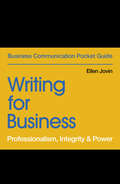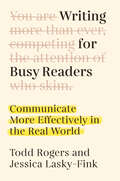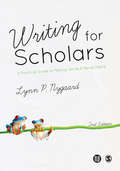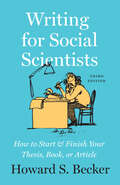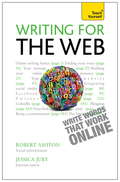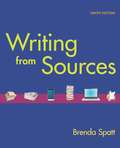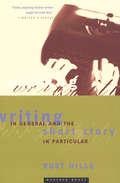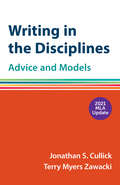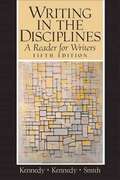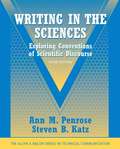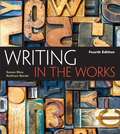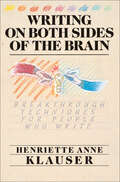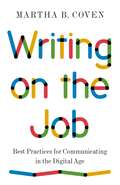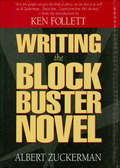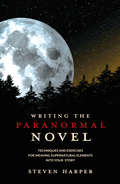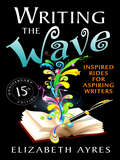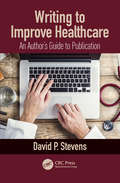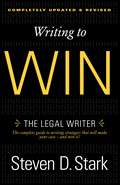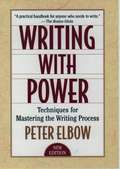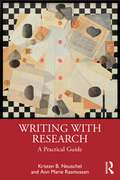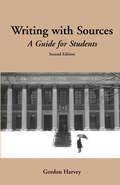- Table View
- List View
Writing for Business: Professionalism, Integrity & Power (Business Communication Pocket Guides)
by Ellen JovinBuild essential skills and write with confidence at work! Immediately practical guide to better business writing designed to help you develop a clear, direct, natural communication style that supports rather than obscures what you want to say. It covers writing principles relevant for a wide range of business documents, including email, letters, memos, reports, proposals, and more, while also offering editing tips to ensure you come across as professional and polished. Packed with examples and tips straight from the workplace.
Writing for Busy Readers: Communicate More Effectively in the Real World
by Todd Rogers Jessica Lasky-FinkWriting well is for school. Writing effectively is for life. Todd Rogers and Jessica Lasky-Fink offer the most valuable practical writing advice today. Building on their own research in behavioral science, they outline cognitive facts about how people actually read and distill them into six principles that will transform the power of your writing: Less is moreMake reading easyDesign for easy navigationUse enough formatting, but no moreTell readers why they should careMake responding easyIncluding many real-world examples, a checklist and other tools, this guide will make you a more successful and productive communicator. Rogers and Lasky-Fink bring Strunk and White&’s core ideas into the twenty-first century&’s attention marketplace. When the influential guides to writing prose were written, the internet hadn&’t been invented. Now, the average American adult is inundated with digital messages each day. With all this correspondence, capturing a busy reader&’s attention is more challenging than ever. This is how to do it.
Writing for Scholars: A Practical Guide to Making Sense & Being Heard
by Lynn NygaardLecturers request your electronic inspection copy here. Academics are not just researchers, but writers too. Using her many years of practical experience gained as a teacher and editor, Lynn Nygaard guides you through the whole process of writing and presenting your research in order to help you make your voice heard within the academic community. Grounded in real world advice rather than abstract best practice, Nygaard demonstrates a number of approaches to writing in order to help you identify those most suited to your own project. This updated new edition includes: Revised and expanded sections in each chapter More focus on the social sciences A more international focus Updated discussions on publishing practices Annotated biographies for each chapter New illustrations and images Additional practical tips and exercises From defining your audience, to forming your argument and structuring your work, this book will enable you to communicate your research passionately and professionally. Lynn Nygaard is Special Adviser on Project Development and Publications at the Peace Research Institute Oslo (PRIO). Visit the companion website for additional online resources! SAGE Study Skills are essential study guides for students of all levels. From how to write great essays and succeeding at university, to writing your undergraduate dissertation and doing postgraduate research, SAGE Study Skills help you get the best from your time at university. Visit the SAGE Study Skills hub for tips, resources and videos on study success! This updated new edition includes: Revised and expanded sections in each chapter More focus on the social sciences A more international focus Updated discussions on publishing practices Annotated bibliographies for each chapter New illustrations and images Additional practical tips and exercises From defining your audience, to forming your argument and structuring your work, this book will enable you to communicate your research passionately and professionally.
Writing for Scholars: A Practical Guide to Making Sense & Being Heard
by Lynn NygaardAcademics are not just researchers, but writers too. Using her many years of practical experience gained as a teacher and editor, Lynn Nygaard guides you through the whole process of writing and presenting your research in order to help you make your voice heard within the academic community. Grounded in real world advice rather than abstract best practice, Nygaard demonstrates a number of approaches to writing in order to help you identify those most suited to your own project. This updated new edition includes: Revised and expanded sections in each chapter More focus on the social sciences A more international focus Updated discussions on publishing practices Annotated biographies for each chapter New illustrations and images Additional practical tips and exercises From defining your audience, to forming your argument and structuring your work, this book will enable you to communicate your research passionately and professionally. Lynn Nygaard is Special Adviser on Project Development and Publications at the Peace Research Institute Oslo (PRIO). Companion Website study.sagepub.com/nygaardwritingforscholars Visit the companion website for additional online resources! This updated new edition includes: Revised and expanded sections in each chapter More focus on the social sciences A more international focus Updated discussions on publishing practices Annotated bibliographies for each chapter New illustrations and images Additional practical tips and exercises From defining your audience, to forming your argument and structuring your work, this book will enable you to communicate your research passionately and professionally.
Writing for Social Scientists: How to Start & Finish Your Thesis, Book, or Article (Chicago Guides to Writing, Editing, and Publishing)
by Howard S. BeckerThe classic guide to avoiding pitfalls and achieving success in academic writing—in a fully updated edition with a new preface by the author.For decades, Writing for Social Scientists has been a lifeboat for academic writers of all fields, from beginning students to seasoned professionals. With reassuring candor, author and sociologist Howard S. Becker identifies some of the common problems all academic writers face, including from procrastination and stifling perfectionism to getting caught up in the trappings of “proper” academic writing, and struggling with the when and how of citations. He then offers concrete advice, based on his own experiences and those of his students and colleagues, for overcoming these obstacles and gaining confidence as a writer.This new edition has been updated throughout to reflect the contemporary landscape of academic writing, offering a new generation of scholars and students encouragement to write about society or any other scholarly topic clearly and persuasively. As academics are called upon to write more often, in more formats, Writing for Social Scientists continues be an important resource for any writer’s shelf.
Writing for the Web: Teach Yourself
by Robert Ashton Jessica JubyLike it or not, the internet has become integral to every aspect of our lives, with smart phones, tablet computers and wifi enabling us to communicate easily and instantly.Whether you're a rising star in the corporate world or a silver surfer, to make an impactonline you have to be able to write clearly, convincingly and in a way that emphasisesyour character too. Best-selling business author Robert Ashton and internet native JessJuby will help you communicate more objectively and effectively online, both at work andat home.
Writing for the Web: Teach Yourself
by Robert Ashton Jessica JubyLike it or not, the internet has become integral to every aspect of our lives, with smart phones, tablet computers and wifi enabling us to communicate easily and instantly.Whether you're a rising star in the corporate world or a silver surfer, to make an impactonline you have to be able to write clearly, convincingly and in a way that emphasisesyour character too. Best-selling business author Robert Ashton and internet native JessJuby will help you communicate more objectively and effectively online, both at work andat home.
Writing from Sources
by Brenda SpattThorough and practical, Writing from Sources is an indispensable guide to source-based composition. Using a skills-based approach, students begin with the building blocks of research writing—annotating a passage and summarizing a source—then progress through more complex steps, such as synthesizing multiple sources and writing a full-length research essay. Along the way, dozens of readings by professional writers and clear, helpful exercises provide models for practice and proficiency. Known for its clear and helpful advice, Writing from Sources teaches the fundamentals of research writing that students will use throughout their college careers.
Writing in General and the Short Story in Particular
by L. Rust HillsHere is a practical guide to writing short stories that explains all the essential techniques of fiction - from character and plot to flashback and foreshadowing - in a way that is both understandable and useful to the beginning writer. Long considered a classic in the field, WRITING IN GENERAL is the product of a lifetime of reflection by one of our best literary minds.
Writing in the Disciplines with 2021 MLA Update: A Hacker Handbooks Supplement
by Diana Hacker Nancy Sommers Jonathan S. Cullick Terry Myers ZawackiThis ebook has been updated to provide you with the latest guidance on documenting sources in MLA style and follows the guidelines set forth in the MLA Handbook, 9th edition (April 2021).With practical advice and plenty of student models, Writing in the Disciplines provides a jump start for writing college papers in nine disciplines — biology, business, criminal justice/criminology, education, engineering, history, music, nursing, and psychology. Each discipline section features information on audience expectations in that area of study, the types of questions asked, the types of documents produced, the kinds of evidence used, appropriate language conventions, and appropriate citation styles. Each section features a model student paper (two in business) written in response to a typical assignment in the discipline. Advice for writing in business, criminal justice, education, nursing, and psychology includes updated APA guidelines (2020).
Writing in the Disciplines: A Reader for Writers
by William J. Kennedy Mary Lynch Kennedy Hadley M. SmithThis combination rhetoric/anthology shows readers how to read academic volumes effectively and how to use them as sources for papers in a variety of disciplines. Throughout, readers learn how to work individually and collaboratively as they move through the entire process of writing from sources?from reading the original source to planning, drafting and revising essays. The rhetoric section teaches readers the fundamental strategies for all phases of academic writing?critical reading, paraphrasing, summarizing, quoting, organizing, drafting, revising, editing, synthesizing, analyzing, researching, and developing arguments. The anthology section offers engaging reading selections that introduce readers to the issues and the methods of study in the sciences, social sciences, and humanities, and that serve as idea banks for their writing assignments. For individuals interested in a comprehensive treatment of academic writing.
Writing in the Sciences: Exploring Conventions of Scientific Discourse
by Ann M. Penrose Steven B. KatzA rhetorical, multi-disciplinary guide, Writing in the Sciences discusses the major genres of science writing including research reports, grant proposals, conference presentations, and a variety of forms of public communication. Multiple samples from real research cases illustrate a range of scientific disciplines and audiences for scientific research along with the corresponding differences in focus, arrangement, style, and other rhetorical dimensions. Comparisons among disciplines provide the opportunity for students to identify common conventions in science and investigate variation across fields.
Writing in the Works (Fourth Edition)
by Susan Blau Kathryn BurakIn this fourth edition, the authors focus on writing as both an academic and practical tool, and updated the content and spirit of the book to prepare you to thrive in the contemporary writing environment. You will learn to write for the digital world--where visual and verbal messages are inseparable--and do so by exploring ideas that will engage the real-world audiences you will encounter long after your college years. Equipped with the skills you will learn for many writing applications--including analyses for college courses, reports and proposals for work, blogs and editorials, podcasts, infographics, and more--you will be prepared to ride the global communication wave as a more confident, capable writer.
Writing on Both Sides of the Brain: Breakthrough Techniques for People Who Write
by Henriette Anne KlauserA revolutionary approach to writing that will teach you how to express yourself fluently and with confidence for the rest of your life.In Writing on Both Sides of the Brain, author Henriette Anne Klauser offers writers breakthrough techniques to break through blocks and create and communicate yourself through words. From working with procrastination and fending off your inner critic to organizing your material and using creative visualization, this informative and empowering guide will help demystify the Right Brain/Left Brain thought processes and keep your words flowing.“Definitely supportive. The biggest block any writer has is self-judgment. Writing on Both Sides of the Brain helps overcome the obstacles and tap into the creative powers within each writer.” —W. Timothy Gallwey, bestselling author of The Inner Game of Tennis“Amusing, interesting, and stimulating . . . should help many potential writers.” —Pulitzer Prize winner Donald M. Murray
Writing on the Job: Best Practices for Communicating in the Digital Age
by Martha B. CovenA practical and compact guide to writing for professionalsWriting is an essential skill in today’s workplace. From messaging platforms and social media to traditional forms of communication like memos and reports, we rely on words more than ever. Given how much reading we do on mobile devices, being able to write succinctly is critical to success. Writing on the Job is an incisive guide to clear and effective writing for professionals.Martha Coven begins with the basics, explaining how to develop a professional style, get started on a piece of writing, create a first draft, and edit it into a strong final product. She then offers practical advice on more than a dozen forms of writing, from emails and slide decks to proposals and cover letters. Along the way, Coven provides a wealth of concrete examples and simple templates that make the concepts easy to understand and apply.Based on Coven’s popular writing classes and workshops at Princeton University as well as her decades of experience in the public and private sectors, Writing on the Job addresses the real challenges professionals face in today’s digital age, and shares essential practices that can improve the performance of any organization.
Writing the Blockbuster Novel
by Al ZuckermanEvery novelist dreams of it--writing the book that rockets to the top of the best-seller lists. Now, they can see how it's done, up close, in a book by an agent who has sold manuscripts that turned into hits.<P><P> Here Albert Zuckerman covers the essential elements of the blockbuster novel and shows writers how to put them to work in their books. Zuckerman covers the subject thoroughly, from creating outlines and building larger than life characters to injecting suspense and more. His instruction is decisive, direct and clear and is supported with examples from Gone With the Wind, The Godfather and other blockbusters.
Writing the Paranormal Novel: Techniques and Exercises for Weaving Supernatural Elements into Your Story
by Steven HarperVampires, werewolves, and zombies, oh my!Writing a paranormal novel takes more than casting an alluring vampire or arming your hero with a magic wand. It takes an original idea, believable characters, a compelling plot, and surprising twists, not to mention great writing. This helpful guide gives you everything you need to successfully introduce supernatural elements into any story without shattering the believability of your fictional world or falling victim to common cliches. You'll learn how to:Choose supernatural elements and decide what impact the supernatural will have on your fictional worldCreate engaging and relatable characters from supernatural protagonists and antagonists to supporting players (both human and non-human)Develop strong plots and complementary subplotsWrite believable fight scenes and flashbacksCreate realistic dialogueAnd much moreComplete with tips for researching your novel and strategies for getting published, Writing the Paranormal Novel gives you everything you need to craft a novel where even the most unusual twist is not only possible-it's believable.
Writing the Wave: Inspired Rides for Aspiring Writers
by Elizabeth AyresWhere's your wave of creativity? If you want to learn how to write, "Writing the Wave: Inspired Rides for Aspiring Writers" is the very first writing book designed especially for beginning writers who yearn to write more expressively. Written with warmth and wit by internationally acclaimed writer and teacher Elizabeth Ayres, this 15th anniversary edition of a classic writing how-to book makes the creative process safe, easy and fun while honoring its spiritual depth and mystery. Elizabeth shows you how it's done. With step-by-step instructions and easy-to-follow writing exercises, you'll be writing non-stop from the very first page, even if you've never written before. It's just like having a personal writing coach. You can learn how to be a writer. Throw away those endless lists of writing prompts. Learn how to discover your own ideas with these break-through writing exercises that transform fundamental writing principles into concrete writing techniques you can use over and over, forever, whether you want to learn how to write fiction, nonfiction, poetry -- or something that doesn't even have a name yet. Unlike other writing books, "Writing the Wave" couples inspiring writing exercises with expert and compassionate advice, to minimize the fears and maximize the joys of writing. And more advanced writers looking for a jumpstart will appreciate recovering their free-flowing creative wellspring. There's a vast ocean of inspiration within you. The surf's up! The water's warm! Are you ready to take the plunge? "Elizabeth Ayres has thought long and hard about the writing process, and is one of the most seasoned and exemplary practitioners in the field of teaching writing. This book about writing is an invaluable distillation of her insights and experiences. I cannot imagine any beginning or struggling writer not coming away with some inspiration from it." (Phillip Lopate, editor of "The Art of Writing" and "Writing New York")
Writing to Improve Healthcare: An Author’s Guide to Scholarly Publication, First Edition
by David P. StevensThis new book is a 'what and how to' guide to writing for successful scholarly publication in the emerging fields of healthcare improvement and patient safety. While there are many useful authors’ aids for scholarly biomedical publication, none focuses explicitly on these relatively new fields. It offers practical advice that includes preparation and organization of a scholarly healthcare improvement manuscript, where to submit it to find the most likely interested editor and journal, how to take full advantage of coauthors’ working together effectively, and strategies for authors to reach a broader health professions readership.
Writing to Win: The Legal Writer
by Steven D. StarkFrom a master teacher, a results-oriented approach to powerful legal writing that communicates, that persuades--and that wins.Of all the professions, the law has the most deserved reputation for opaque, jargon-clogged writing. Legal education, which focuses on judicial opinions, not instruments of persuasion, is partly to blame. Yet forceful writing is one of the most potent weapons of legal advocacy. In Writing to Win, Steve Stark, a former teacher of writing at Harvard Law, who has taught thousands of aspiring and practicing lawyers, has written the only book on the market that applies the universal principles of vigorous prose to the job of making a case--and winning it.Writing to Win focuses on the writing of lawyers, not judges, and includes dozens of examples of effective (and ineffective) real-life writing--as well as models drawn from advertising, journalism, and fiction. It deals with the problems lawyers face in writing, from organization to strengthening and editing prose; teaches ways of improving arguments; addresses litigation and technical writing in all its forms; and covers the writing attorneys must perform in their practice, from memos and letters to briefs and contracts. Each chapter opens with a succinct set of rules for easy reference.No other legal writing book on the market is as practical, as focused on results, as well written as Writing to Win.From the Trade Paperback edition.
Writing with Confidence: Writing Effective Sentences and Paragraphs
by Alan MeyersWriting With Confidence, a value-priced developmental writing book, provides essential instruction and practice in basic writing skills at the sentence and paragraph level. The first developmental book to include incorporate high-interest, connected discourse subject matter in its exercises,Writing with Confidenceretains and expands on this feature. Most chapters pursue a theme throughout the exercises-the dreams and premonitions surrounding the death of Abraham Lincoln; animal facts and oddities; the gustatory achievements of Diamond Jim Brady, the world's greatest eater; the voyage of the Kon-Tiki; and so on. The text's six-unit structure includes thirty short chapters on the writing process, paragraph organization and development, the shape of the essay, all the rhetorical modes, and all the sentence skills. The writing chapters are fully process oriented, showing the development of a paragraph in six steps, from planning and outlining through drafting, revising, editing, and proofreading. Optional collaborative activities are provided in the margins of each chapter. This focus on writing is balanced with equal attention to sentence skills, not only for native speakers of English who need help, but for non-English-dominant speakers as well. ESL boxes provide help for readers whose first language is not English, as do the two final chapters of the book, which address troublesome matters such as verb phrases, word order, articles, and prepositions. The reading-writing connection throughout the book has been expanded, with sixteen additional readings in the last unit of the book. And the popular "Blueprints for Writing" found in the rhetorical chapters have been carried into unit ending "Blueprints for Success," in which the most important concepts and practices are summarized in graphs and charts. For those seeking to develop their writing skills at the sentence to paragraph level.
Writing with Power: Techniques for Mastering the Writing Process,Second Edition
by Peter ElbowEmploying a cookbook approach, Elbow provides the reader (and writer) with various recipes: for getting words down on paper, for revising, for dealing with an audience, for getting feedback on a piece of writing, and still other recipes for approaching the mystery of power in writing. In a new introduction, he offers his reflections on the original edition, discusses the responses from people who have followed his techniques, how his methods may differ from other processes, and how his original topics are still pertinent to today's writer. By taking risks and embracing mistakes, Elbow hopes the writer may somehow find a hold on the creative process and be able to heighten two mentalities--the production of writing and the revision of it.
Writing with Research: A Practical Guide
by Kristen B. Neuschel Ann Marie RasmussenWriting with Research offers readers practical guidance for managing writing and research as combined tasks. Kristen B. Neuschel and Ann Marie Rasmussen bring expert advice from their extensive experience as writers, researchers, and teachers, making this an indispensable, user-friendly guide to research-based writing.This book describes how to launch writing and researching together and how to continue the work as an iterative, not linear, process. It explores the challenges of finding time for writing and research, and offers tips on how to make progress, even in short writing and researching sessions. It describes the steps necessary for responsible research in the contemporary digital environment, including the role Artificial Intelligence might play and how to map arguments as they emerge through writing. This book offers readers the tools to confront stumbling blocks like procrastination. It shows the benefits of building writing communities and how to make use of feedback at various stages of a project.The short and easily digestible chapters make this a go-to resource for a wide audience, from students, professors, and scientists to professionals. Writing with Research helps all researchers find the resources they need to be successful and encourages them to think of themselves as writers, now and into the future.
Writing with Sources: A Guide for Students
by Gordon HarveyDeveloped for Harvard University's Expository Writing Program, Writing with Sources describes the main principles and methods of integrating and citing sources in scholarly work, and provides cogent guidance on avoiding the misuse of sources.The second edition of Writing with Sources is updated throughout, and includes new material on the roles sources play in argument, on assessing the reliability of sources, and on attitudes about writing that can lead to plagiarism.
